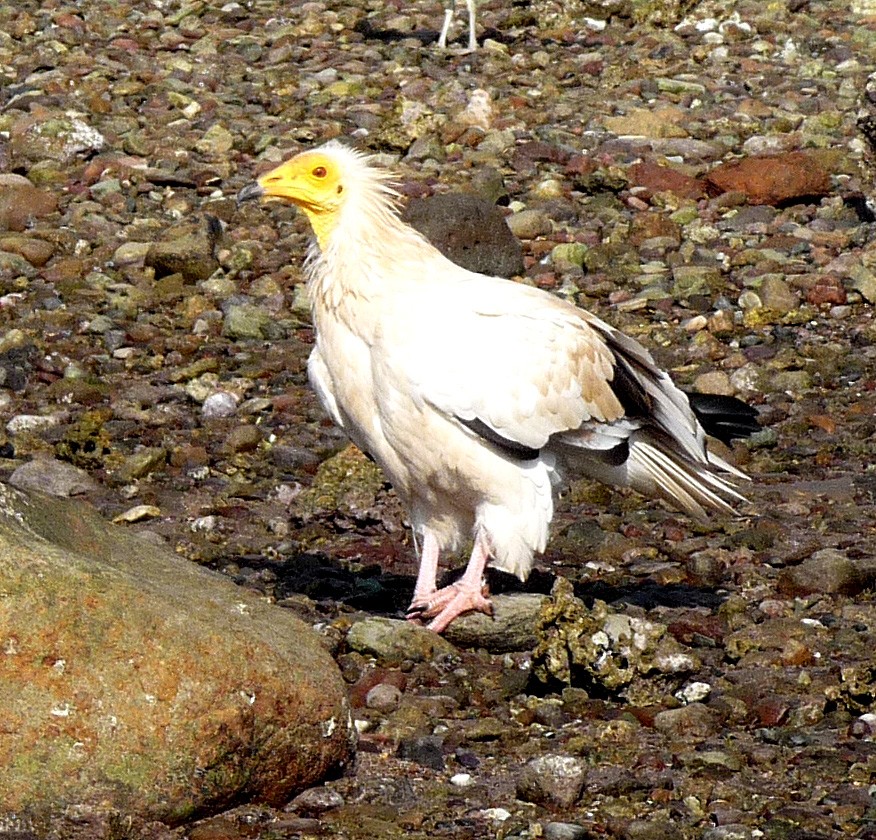Egyptian Vulture
A species of Egyptian Vulture Scientific name : Neophron percnopterus Genus : Egyptian Vulture
Egyptian Vulture, A species of Egyptian Vulture
Botanical name: Neophron percnopterus
Genus: Egyptian Vulture
Content
Description People often ask General Info
Description
The adult's plumage is white, with black flight feathers in the wings. Wild birds usually appear soiled with a rusty or brown shade to the white plumage, derived from mud or iron-rich soil. Captive specimens without access to soil have clean white plumage. It has been suggested as a case of cosmetic colouration. The bill is slender and long, and the tip of the upper mandible is hooked. The nostril is an elongated horizontal slit. The neck feathers are long and form a hackle. The wings are pointed, with the third primary being the longest; the tail is wedge shaped. The legs are pink in adults and grey in juveniles. The claws are long and straight, and the third and fourth toes are slightly webbed at the base. The bill is black in the nominate subspecies but pale or yellowish in adults of the smaller Indian ginginianus. Rasmussen and Anderton (2005) suggest that this variation may need further study, particularly due to the intermediate black-tipped bill described in rubripersonatus. The facial skin is yellow and unfeathered down to the throat. The sexes are indistinguishable in plumage but breeding males have a deeper orange facial skin colour than females. Females average slightly larger and are about 10–15% heavier than males. Young birds are blackish or chocolate brown with black and white patches. The adult plumage is attained only after about five years. The adult Egyptian vulture measures 47–65 centimetres (19–26 in) from the point of the beak to the extremity of the tail feathers. In the smaller N. p. ginginianus males are about 47–52 centimetres (19–20 in) long while females are 52–55.5 centimetres (20.5–21.9 in) long. The wingspan is about 2.7 times the body length. Birds from Spain weigh about 1.9 kilograms (4.2 lb) while birds of the Canary Island subspecies majorensis, representing a case of island gigantism, are heavier with an average weight of 2.4 kilograms (5.3 lb). 
Size
70 cm
Colors
Black
Bronze
Gray
White
Life Expectancy
37 years
Nest Placement
Cliff
Feeding Habits
Egyptian Vulture is a versatile scavenger, primarily consuming carrion, but also hunts birds, mammals, and reptiles. It feeds on a variety of other foods such as eggs, insects, mollusks, and aquatic crustaceans. Uniquely, egyptian Vulture also consumes animal dung, showcasing its adaptability in diet.
Habitat
Egyptian Vulture typically resides in open, arid environments like steppes, deserts, and scrublands, as well as savannas, grasslands, and mountainous regions with rocky outcrops for nesting. Found from sea level to 3000 meters, these birds adapt to temperate to tropical climates and can be seen near both dry and marginally wet or cold areas, often scavenging in urban settings.
Dite type
Scavenger
People often ask
General Info
Feeding Habits
Bird food type
Behavior
The Egyptian vulture is usually seen singly or in pairs, soaring in thermals along with other scavengers and birds of prey, or perched on the ground or atop a building. When it joins other vulture species at a dead animal, it tends to stay on the periphery and waits until the larger species leave. In the Iberian Peninsula, landfills are an important food source, with the vultures more likely to occupy territories close to landfill sites. 
Distribution Area
Egyptian vultures are widely distributed across the Old World with their breeding range from southern Europe to northern Africa east to western and southern Asia. They are rare vagrants in Sri Lanka. They occur mainly on the dry plains and lower hills. In the Himalayas, they go up to about 2,000 metres (6,600 ft) in summer. In Armenia, breeding pairs have been found up to 2,300 meters a.s.l. Most Egyptian vultures in the subtropical zone of Europe migrate south to Africa in winter. Vagrants may occur as far south as in South Africa although they bred in the Transkei region prior to 1923. They nest mainly on rocky cliffs, sometimes adopting ledges on tall buildings in cities and on large trees. Like many other large soaring migrants, they avoid making long crossings over water. Italian birds cross over through Sicily and into Tunisia making short sea crossings by passing through the islands of Marettimo and Pantelleria with rare stops on the island country of Malta. Those that migrate through the Iberian Peninsula cross into Africa over the Strait of Gibraltar while others cross further east through the Levant. In summer, some African birds fly further north into Europe and vagrants have been recorded in England and southern Sweden. Migrating birds can sometimes cover 500 kilometres (310 mi) in a single day until they reach the southern edge of the Sahara, 3,500 to 5,500 kilometres (2,200 to 3,400 mi) from their summer home. Young birds that have not reached breeding age may overwinter in the grassland and semi-desert regions of the Sahel. 
Species Status
Healthy adults do not have many predators, but human activities pose many threats. Collisions with power lines, hunting, intentional poisoning, lead accumulation from ingesting gunshot in carcasses, and pesticide accumulation take a toll on populations. Young birds at the nest are sometimes taken by golden eagles, eagle owls, and red foxes. Only rarely do adult birds attempt to drive away predators. Egyptian vulture populations have declined in most parts of its range. 
